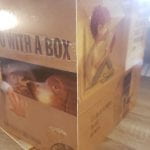Jacqui Reid-Walsh
In late spring Dr. Emily Aguiló-Pérez (West Chester University, PA) gave a provocative zoom talk as part of the Object Talks: What Books as Material Artifacts Reveal series presented by the West Chester University Center for Book History and the Francis Harvey Green Library Special Collections. Her talk was entitled “Transmediating Texts for Children: The Case of Board Books.”
Dr. Aguiló-Pérez took a material culture approach to board (or baby) books – a little-studied kind of children’s book that can be made of other materials like cloth or plastic. Intriguing to me were the connections she made between board books and moveable books.
In her broad ranging slide-show she raised provocative historical and material connections about the past and present. Notably, she began with a brief discussion of the horn book (often composed literally of board) with a piece of paper protected by horn attached. Since it was small and bat shaped it could be worn on at the waist and be played with after the alphabet was learned.
In her discussion of contemporary board books she includes numerous aspects: the importance of size and shape; the affordances of various interactive components, especially flaps, folds and holes; and how many of these texts are transmediated from picture books or even classic novels. Her discussion of the use by the child players includes the category “chewables” (a perfect term!), as well as referring to other multimodal features like sound.
For instance, in her discussion of a book called What to Do with a Box, she describes it as a folded book. She notes how in the process of setting up the object it can become something else. For example, this could be a tent or a tunnel. Or it could be a plane. And so the child can explore the “box” in ways that follow but also go beyond its intended shape and the ideas the book offers the child.
In her final book discussed, Room on the Broom, she analyzes both material and digital transmediations that may reproduce or shrink or expand the text from the original picture book depending on the textual qualities of the book and the appropriateness of the adaption. She observes how this example both reproduces and alters the original narrative.
She notes that what the board book maintains from the original picture book is its short length and images. Yet at the same time, the push, pull, and slide affordances change various aspects of the book. She observes that the movable parts invite the child to interact with it in new ways – but also that these ways are designated, not open, such as changing the point of view. This aspect aligns the books with what many board books set out to do: present/teach simple concepts to babies. She ends her presentation with an animated version of the book that expands the short text to a 25 minute film that is available on Netflix.
These are only some highlights of her fascinating talk that importantly draws attention to the overlooked category of moveable board books and includes it in the discussion of what is a movable book.

